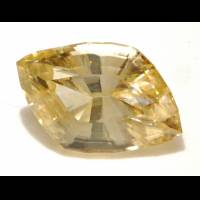Aragonite

BĂlina, Teplice District, ĂšstĂ nad Labem Region, Czech Republic
17.98 carats
© Rarestone.com
Aragonite is a polymorph of calcite, having the same chemical composition but a different physical structure. When aragonite is heated to 400°C it will convert to calcite.
Aragonite occurs in compact, granular, massive or radially fibrous forms. Crystals are often twinned and form pseudohexagonal prisms. They are usually white or colourless but may have brown, grey, green or violet hues. Transparent crystals of aragonite are found in many places, particularly in Bohemia, Spain and the north of England. Massive material is found in horizontal layers. A layered sedimentary marble-like material is sometimes referred to Mexican Onyx and is used for carvings and ornamental objects.
Aragonite forms the basis for many organic gems, such as coral, mother-of-pearl and pearl.
Aragonite Gemstones by Colour
This table shows the variety of hues this gemstone can be found in. Click on a photo for more information.
Aragonite Gemstones by Size
This table shows distribution of Aragonite gemstone sizes that are listed on this site. This can give a good indication as to the general availability of this gemstone in different sizes.
Contributed photos
Lightest:6.45 cts
Heaviest:22.82 cts
Average:11.96 cts
Total photos:10
Do you have a larger Aragonite? Why not upload a photo?
| General Information | ||||||||||||||||||||||
|---|---|---|---|---|---|---|---|---|---|---|---|---|---|---|---|---|---|---|---|---|---|---|
| Chemical Formula |
| |||||||||||||||||||||
| Physical Properties of Aragonite | ||||||||||||||||||||||
| Mohs Hardness | 3.5 to 4, Blue Chart Gem Identification (2010) More from other references | |||||||||||||||||||||
| Specific Gravity | 2.93 to 2.96, Blue Chart Gem Identification (2010) More from other references | |||||||||||||||||||||
| Tenacity | Brittle, Gemstones (2009) Very brittle | |||||||||||||||||||||
| Cleavage Quality | Distinct, Gemstones (2009) | |||||||||||||||||||||
| Fracture | Sub-Conchoidal, Gemstones (2009) | |||||||||||||||||||||
| Heat Sensitivity | Moderate, Gemstones (2009) | |||||||||||||||||||||
| Optical Properties of Aragonite | ||||||||||||||||||||||
| Refractive Index | 1.525 to 1.686, Blue Chart Gem Identification (2010) More from other references | |||||||||||||||||||||
| Optical Character | Biaxial/-, Blue Chart Gem Identification (2010) More from other references | |||||||||||||||||||||
| Birefringence | 0.155, Blue Chart Gem Identification (2010) DoublingMore from other references | |||||||||||||||||||||
| Pleochroism | Strong, Gemstones (2009) | |||||||||||||||||||||
| Dispersion | Low, Gemstones (2009) | |||||||||||||||||||||
| Colour | ||||||||||||||||||||||
| Colour (General) | White, yellowish, reddish, greenish, bluish, violet. Commonly banded, Gemmological Tables (2004) More from other references | |||||||||||||||||||||
| Transparency | Transparent,Translucent,Opaque, Gemmological Tables (2004) More from other references | |||||||||||||||||||||
| Lustre | Vitreous, Gemstones (2009) | |||||||||||||||||||||
| Fluorescence & other light emissions | ||||||||||||||||||||||
| Fluorescence (General) | Common orange or cream, Blue Chart Gem Identification (2010) More from other references | |||||||||||||||||||||
| Fluorescence (Short Wave UV) | Green-white, pink, white, Gemstones (2009) | |||||||||||||||||||||
| Fluorescence (Long-Wave UV) | Pink, white, Gemstones (2009) | |||||||||||||||||||||
| Crystallography of Aragonite | ||||||||||||||||||||||
| Crystal System | Orthorhombic, Blue Chart Gem Identification (2010) More from other references | |||||||||||||||||||||
| Habit | Frequently shows pseudohexagonal habit which is caused by combination and twinning, Gems, Sixth Edition (2006) More from other references | |||||||||||||||||||||
| Geological Environment | ||||||||||||||||||||||
| Where found: | Typical deposits occur at hot springs, in cavities in volcanic rocks and in cave formation., Gemstones (2009) | |||||||||||||||||||||
| Further Information | ||||||||||||||||||||||
| Mineral information: | Aragonite information at mindat.org | |||||||||||||||||||||
| Significant Gem Localities | ||||||||||||||||||||||
| ||||||||||||||||||||||









